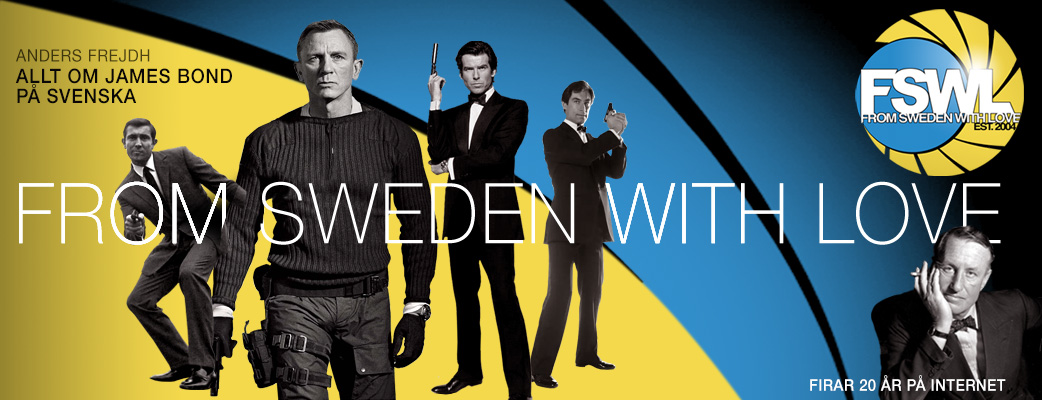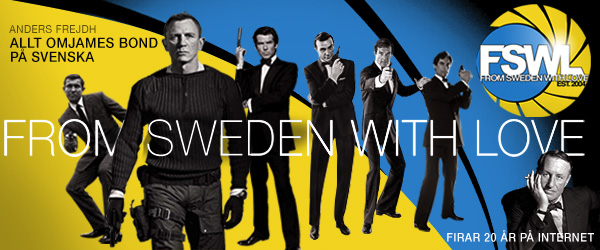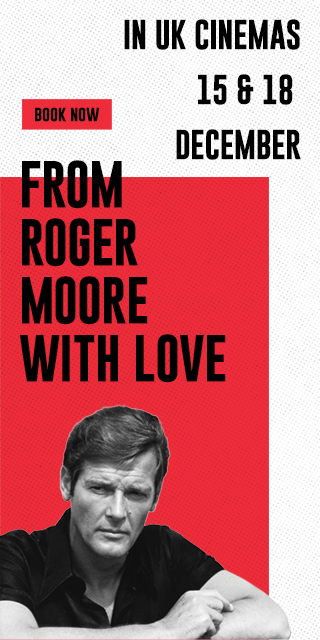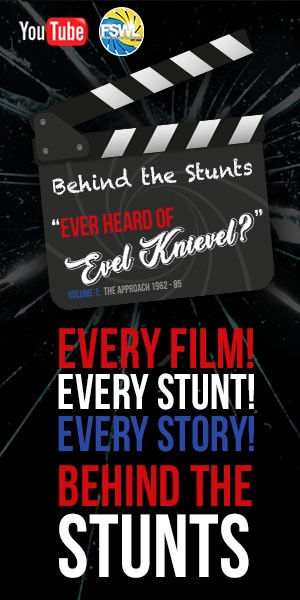Hemsidan senast uppdaterad: 2025-06-10
Hem
Bok- och filmrecensioner
Event
FSWL Merchandise
James Bond 007 artiklar
James Bond 007 filmerna
James Bond 007 litteratur
James Bond 007 nyheter
James Bond 007 produkter
James Bond 007 samling
James Bond 007 shop
James Bond 007 spel
James Bond fanklubbar
James Bond personligheter
Svenskar i Bond-filmerna
TûÊvlingar
Till minne av
Intervju med rekvisitûÑren Tony Teiger - den fûÑrst filmade Blofeld
Av: Anders Frejdh
Publicerad:
2018-01-20
2018-01-20
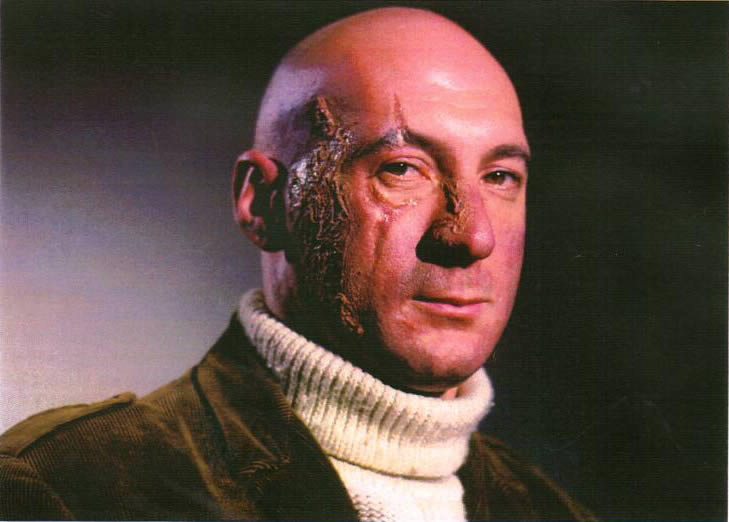
Om du trodde att den fûÑrsta visuella presentationen av Blofelds ansikte var den brittiska skûËdespelaren Donald Pleasance ûÊr du fel ute. JasûË, inte han? Hm, den fûÑrsta filmversionen av Blofeld var naturligtvis Jan Werich, den jultomtsliknande tjeckiska skûËdespelaren som ursprungligen valdes fûÑr rollen i You Only Live Twice men senare ersattes av Pleasance - eller hur? Inte?! Blofeld visualiserades fûÑrst i filmen av den brittiska rekvisitûÑren Tony Teiger. Vem? Tja, lûËt Tony berûÊtta fûÑr dig:
Eye of The Teiger
ãI was born in Birmingham, England, in 1936. My father was a tailor whose family came from Poland in the late 19th century and arrived at Cardiff. My father was born in Wales. My motherãs family was originally from Russia and fled that country because of the various pogroms that engulfed it. I was one of four children. I had two brothers and a sister. My sister died in a road accident when she was only nine years old a n d my elder brother sadly passed away some time ago. However, my younger brother Joe is a successful producer of TV commercials in New York. My father always wanted me to go into his business, tailoring, which I really didnãt want to do. So, funnily enough I went to study agriculture in Sussex. Then I travelled the world basically. I went off to the Middle East, Scandinavia and ended up, ironically in Birmingham! Whilst there I joined the theatre, the Birmingham Rep, as a Showman, come whatever. As a Showman, you were on hand to assist the productions by doing the props, flies, whatever was required. The period would have been about 1955 or ã56. Shortly afterwards I moved to London. Incidentally whilst with the theatre in Birmingham I had joined the theatre union NATKE (National Association of Theatrical and Kine Employees), which you had to join then to be able to work in the industry. So, when in London I started working in theatres there ã The Royal Court, Princes, DãOyly Carte Opera, The Savoy Theatre. I remember doing a play with Robert Shaw ã The Changeling at the Royal Court Theatre in 1961 ã he was a major celebrity then. Eventually, in between jobs, I went to the union offices to see if anything new was available and I was told ãwell, you could go to Pinewood Studios if you want to, they are looking for peopleã. So, I did, staying with Pinewood Studios until I went freelance and thatãs how I got into films!ã
The film industry was different in those days, ãWhen I started, I had a young family to feed and I was flexible ã then as now the film industry paid double the wages of the theatre so it was a very attractive option. Anyway, I was always interested in movies and keen to get into the industry. However, funnily enough, the first job I did involved pulling nails out of pieces of used wood in the Stage Hand Carpentry Shop! Shortly afterwards, somebody said to me ãListen you want to transfer over to the Props Department. Thatãs the department to go to.ã So, I applied and I got into the Props Department. Thatãs where Iãve been ever since.ã
Prop Life
Tony is keen to clarify roles, ãPeople get mixed up with Props and Wardrobe and Special Effects (SFX). In the film industry, theyãre distinct departments ã although at some points they do overlap. For instance, when it comes to certain ãgadgetsã that are needed then the Props Master will have them made and he might use an SFX guy or outfit through the SFX department but the result will be a ãPropã or a ãHand Propã. Basically, Props are everything you see in this room (Tony sweeps his arms around pointing to all of the objects in his sitting room), literally everything in this room from furniture, to the television, objects and implements on the table, wall decorations, the actual construction and painting of the set. We have a ãDrapes Departmentã who deal just with drapes (curtains). Everything is co -ordinated through the Production Designer and the Art Department ã you are basically working in co-ordination with them. Sometimes you find that particularly Art Directors or Set Decorators say ãI donãt want to know about this or thatã and because they have confidence in you that you can do it and understand whatãs required. If itãs a war film, for example the set decorator might say ãI donãt want to know about all this army stuff! You go and do it.ã Itãs a co-ordination really with the Designer, Art Director and of course, the Director. The Directors and Producers naturally have their opinions and feeling about what is right and, anyway, you must have the Directorãs approval.ã
Tony outlined it was exacting job, ãTo avoid arriving on set and hearing the Director saying, ãWhatãs that? I donãt like it,ã you have to have pre-production meetings over quite a lengthy period to ensure everything is OK. For instance, with a Bond film pre-production could be six months before you start filming. Preparation and scrutiny of the script and breaking it down for your department so that everything in the script appertaining to your department is covered, as it were, in conjunction with numerous meetings to discuss details and agree who is responsible for different aspects of each scene, requires enormous effort. I guess itãs like the endeavours of any large company sitting down to decide what must be done about a project.ã
Tony was assiduous in his duties, ãWe did other things of course. The department is split up in certain ways. For example, you have what they call ãdressing propsã. Those are the guys who in conjunction with the Art Department have ãan eyeã for manipulating the furniture and putting up pictures, etc. Then you have what are called ãStandby Propsã and these people are on the floor with the Director and they handle all the ãHand Propsã as necessary ã maybe guns, cigarette lighters and cigarettes ã or whatever else is called for. For example, if somebody is sitting down and having a conversation like we are and they are drinking a cup of coffee, the prop man must make sure that the coffee is in the cups and that the coffee is kept hot. ãTake two!ã and then you must clear away and start all over again as it were. So, they are responsible for all the on-set props. They are obviously fed via the prop master to the stand-bys and via the prop master via the art department, set decorators and buyers who find the required material in the first place. The Prop Masterãs job is to co-ordinate all that Iãve mentioned. He co-ordinates the whole department, whether itãs vehicles, arms, weapon and of course, the manufacture of items as required.ã
Role of Honor
It was in this capacity he came to the attention of Bond, James Bond, ãI think everyone was [surprised by the success] after the first film. But not by the second or the third, then everyone loved it. Today, regardless of who is playing the lead, there is such a following, such a cult thing, that even younger people who werenãt alive in the 1960s and 1970s are big fans today.ã
By the fifth Bond film, ideas literally came out of the blue, ãWell, on You Only Live Twice for example, we had the wonderful little autogyro Little Nellie that was shipped out to Japan. I remembered we waited quite a while for it to arrive and when it did everyone was fascinated to see this tiny machine that someone was supposed to get into and fly! I think it was Ken Wallis himself [it was indeed] who flew it for the movie.ã Tony was in control in the land of the rising Bond, ãIn Japan, Sean Connery was very famous at that time and they were Bond crazy there, but although there were quite reasonable crowds outside some of the locations we used, notably the hotels, it was never a problem.ã
Sometimes, crew members made it to the screen, ãI remember that the producers wanted a girl to drive the open-topped Toyota car. There was a young clapper loader [Michael Messenger] who was a ãbit of a ladã and a very good driver. I suppose then he must have looked a little shall we say ãfeminineã then, because they gave him a wig and he was the one driving the car!ã
Right Idea, Wrong Blofeld
Teiger nearly got a second, onscreen life on the film too: ãIt was You Only Live Twice with Sean in 1967. It was made at Pinewood and on location in Japan. I wasnãt the Prop Master on that I was just the Stand-By Prop on the floor, as they say it. It was very interesting. Whilst I was doing something on one of the sets during the rather lengthy period of pre-production I noticed that producers Cubby Broccoli and Harry Saltzman and one or two of the other guys ã everyone knew each other on set ã kept on looking at me. I thought ãwhat am I doing wrong?ã The prop master was about to become a minor but interesting film history footnote, ãEventually they came over and they said ãTony, would you mind doing something, a favour, for us?ã I said ãSureã.
In the Fleming novels, Blofeld is quite different to his onscreen creation. In Thunderball (1961), Blofeld was a massive, 6 foot 3 inch tall, 130kg man with crew cut black hair and black eyes. By On Her Majestyãs Secret Service (1963), he had deliberately altered his appearance and was now tall and thin, 76 kg in weight, has long long silver hair, a syphilitic nose, no earlobes and dark green tinted contact lenses to hide his distinctive black eyes. In his final literary appearance, You Only Live Twice (1964), Blofeld has muscle, a gold-capped tooth and drooping grey moustache.
For the first on screen appearance, Blofeld was bald and mad to have a scar stretching across his face and eye. This would have to be artificially applied. The producers needed Tony, ã'Would you mind doing some make-up tests for us?' they continued. I ask why and they told me ãDonald Pleasence, whoãs going to play Ernst Blofeld, is not available and because you look a little like him we wondered if you would do some make-up tests for us.ã Tony stepped into history, ãI agreed and they took me over to Make-up and shaved my head, put scars all over my face and other make-up and we went back to the studio floor and they filmed me. In fact, we went back and forwards several times, applying and removing different make-up and filming the results to judge the best procedure to use when Donald became available. Of course, it was a proper screen test and I guess the rushes were sent to Donald Pleasence, but fortunately I still have those photos.ã
Tony Teigers make-up test som Ernst Stavro Blofeld fûÑr You Only Live Twice. Copyright Eon Productions. Alla rûÊttigheter fûÑrbehûËllna.
Tony is wistful, ãIncidentally, there are a couple of funny stories relating to those photos. At the end of the day I didnãt take the make-up off. I was living in Londonãs Notting Hill Gate at the time and because I didnãt have a car at the time I went home on the tube, from Uxbridge. When I got home from the underground station I knocked on the door of my flat just to see the reaction of my wife who gasped ãWhatãs happened to you?ã Fortunately, I was paid something for the make-up tests and when I returned to my normal job, some of the boys I worked with at Pinewood said ãAre you going to share the money youãve made whilst youãve been messing about and weãve been doing your job?ãã
Over the years, Tony got to know Sean Connery, ãI like him very much. Occasionally we play golf together. With my wife Cindy being quite unwell, he and his wife Micheline, regularly ask after her. They are very caring. Thereãs no doubt heãs my favourite Bond.ã
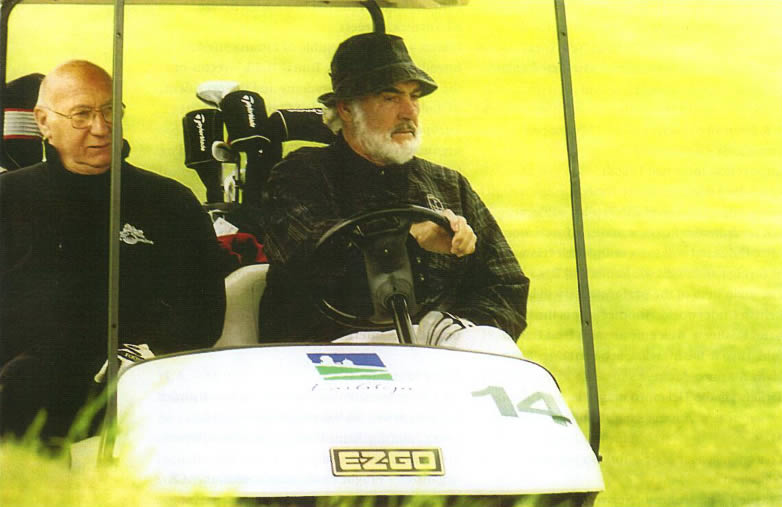
Tony Teiger golfar med Sean Connery i Tjeckien 2002 under produktionen av The League of Extraordinary Gentlemen.
Living Twice
Teigerãs Bond journey did not end in 1967 ã 30 years later he would return: ãIn the early days only permanent staff at Pinewood worked on Bond films. Before I went to Japan (for You Only Live Twice). Before the changes in the infrastructure of film industry, the studios themselves had massive store-rooms of items they had collected from various films and other things and built over long period of production. These items stayed within their stores in the Prop Department. Unless it was hired or borrowed from someone and returned, it was kept. Of course, they didnãt save everything but they kept a lot of stuff. If you went to any studios in the ãStates, such as Universal they had massive stores. Since the studios went ãFour Wallsã ã whereby they didnãt just produce their own films, they rented out the studios, the four walls, for others to use, but clients had to provide everything else. Before, the studios owned the crew, props and everything required. When I worked on Tomorrow Never Dies, I could as a freelancer because, by then, the whole system had changed.ã
Teiger was able to meet the challenge due to his formative years. ãWell, now that the unions are basically non-effective ã that is you can ãt go down to the union office and ask them if they have any work ã today I donãt think theyãd find you work and itãs more a matter of going on training courses or attending film school. Nowadays people establish early goals: ãI want to be a camera manã, ãI want to be a directorã, ãI want to be a producerã etc.ã Flexibility is key, ãI donãt find anything particularly ãdifficultã. I feel that if somebody asks me to organise something I can, be it the Scud missile for Tomorrow Never Dies. We got many of the weapons from Bapty & Co who specialise in firearms props. Nowadays youãd get an armourer because of the new regulations and laws.ã
It was Teiger who made a key modification ãIn fact, I once suggested changing Bondãs gun. We thought Bondãs original gun [Sean Conneryãs famous Walther PPK] was too small. So, I asked Bapty & Co to produce a prop of a larger version of the weapon. I thought, as did many otherãs ãisnãt it about time that we changed Bondãs gun? I suggested the change to the producer, Barbara Broccoli, the director, Roger Spottiswoode and the art department.ã As a result, Pierce Brosnanãs Bond adopted the Walther P99 handgun.
Donãt Think of The Danger
Working on Bond can be dangerous, ãThere are more rules. Health and Safety has become a much bigger factor in studios, not so much on location. For instance, now when you go onto a set, a lot of the time youãve got to wear a hard hat! Itãs so funny seeing directors and producers walking around these days wearing hard hats ã especially if set construction is taking place when you are simply not allowed to go on the floor without a hard hat for safety reasons. It has gone a bit too far I think.ã
Bond films are a logistical exercise, ãGetting it all organised on location every morning gives me a buzz. It doesnãt faze me at all. It can sometimes be aggravating from an organisational point-of-view but then I would say that nine times out of ten itãs just part of the job. Part of the organisation. You are on the telephone all day, you are going to see things, travelling here, taking drawings to show certain people so that you can have items made or finding somebody in your team who can manufacture them. All part of the job. Iãm given an office and facilities but I donãt pay people. I am given a prop budget and after discussions with the producers I might say that I need 20 guys or 30 guys ã ã5 guys to do this and 6 guys to do thatã. I might ask for a pool of days that I can call upon if things need to change quickly because of changing circumstances ã especially weather ã and you find you need to alter the schedule.ã
The Bond films are big, ãNormal Bond films are a crew of 600 people. It is less glamorous to us because itãs a job of work. On Tomorrow Never Dies, for example, at one stage our department comprised 50 or 60 people. When we had to build the market for the motorbike scenes, which were filmed at Pinewood and at Frogmore Studios in Hertfordshire, where we took over a warehouse and built a whole street and all the shops. We had masses of stuff there. We were collecting studios. We had about 200 old Vespa scooters and rickshaws gathered from all over the place.ã
Collectormania
Tony explains what happens to all that material, ãAt the end of every Bond movie, all the props and pieces of equipment seen on screen are the property of the company and at the end of the film everything stays with them. Officially everything goes back to them and you arenãt allowed to take anything without the companyãs permission. Now they might decide to have an auction to sell of unwanted items, props and various things. If there are things that might be of use to other producers then there might be an auction, or you sell them to a hire company. Indeed, lots of hire companies have bought what you might call ãincidentalsã. All the weapons would have been hired of course and they would go back to specialist armourers like Bapty & Co. Of course, a great deal of material goes back into the production companyãs own stores, probably at Pinewood.ã
Teigerãs work also affects the collectables market, ãAnyone producing a toy or a collectable has obtained a license to do so from Eon Productions [the rights owners]. Consequently, these people will be shown the fruits of the Art Departmentãs labours and will see what is being featured in the actual movie. First, it must be remembered that everyone works to the script and all the gadgets and vehicles are mentioned there. Once a script has been finalised, you have meetings to discuss specific weapons, etc with the director and producers. Any new developments are illustrated, discussed and agreed at these meetings.ã
Beyond Bond
Apart from his work on the Bonds, Tony has worked with on many classics, with many classic stars: ãCleopatra with Richard Burton and Elizabeth Taylor in 1963. They shot it at the back lot at Pinewood and then they went to Rome. In those days such films had huge crews and if youãre a small cog in a big wheel like I was you can be give n some rather tedious jobs. I donãt know if you remember there were scenes featuring lots of yellow flowers. Well, there was a line of guys in the prop room and their job was to cut up pieces of yellow tissue paper and curl them up to make them look like flowers. There were sacks and sacks of them. We worked for three or four weeks making them, cutting, twiddling and making plants.ã
Tonyãs also had long association with fabled military costume expert John Mollo, who won the Costume Design Oscar for 1977ãs Star Wars ã Episode IV: A New Hope. They worked together on The Charge of The Light Brigade and Ghandi. Rather than securing any weapon props, Molloãs role principally entailed finding the military uniforms for the wardrobe department and what Tony described as the ãlogisticsã of what an army would do ã ãhow they would actã.
Tony was sanguine about his famous colleagues, ãI wouldnãt say I was ãstar struckã. Funnily enough, if you are working on a project, regardless of which department you might be in, the sound department, camera department or the prop department, you do ãrub shouldersã with the artistes. You might have to give them their watches in the morning or another specific prop or item of wardrobe. Most of them are just ordinary people. You simply look after them, making sure they have their chair or whatever it is they need and you bond to a certain extent. However, from my point of view I just treated people as ordinary people and, consequently the artists treated me as an ordinary person. Obviously, some people donãt want to mix with crews but I would say that most artists, film people especially, realise that without the crew things donãt get done and films donãt get made! You need your electricians, your riggers, your props, your wardrobe, your make-up and hair.ã
Stars can sometimes be awkward, ãI had some guns made for an artist who showed me some pictures and asked, ãcan we have some guns made like this?ã So, I looked at them and had some guns made and showed them to the artist. He liked some of them but he didnãt like certain things (sighs) so we went away and changed things to what he wanted. When we came back again he changed his mind again. So, once more we had to go back and amend them... However, it depends how much influence they have, especially script wise, in their contracts, where they can change the lines for example. But you always try to make everybody happy. First of all you show a director something and he likes it. Then you show an artist something and he might not like it... So, you then say to the director ãWell, he doesnãt like itã or ãhe doesnãt want itã and you let them have the discussion so that they can make up their minds and perhaps reach compromise. But, yes there are times, especially in modern day weaponry where you see some of the weaponry designed and wonderãÎã
Family Business
Tony Teiger also worked on Lawrence Of Arabia, Khartoum, Operation Daybreak, the Guy Hamilton directed films of Force 10 From Navarone and Evil Under the Sun, The Far Pavilions, Dry White Season, The English Patient, Highlander 4 and Blade where Tony was in charge as Property Master.
Today, Tonyãs son, Ty Teiger, is following a similar career path. ãHe has worked on three Star Wars productions and two Bonds [the 2002 film Die Another Day and the 2006 film Casino Royale], so heãs more into making stuff than I was. In the early days I used to take him to various sets and locations and then got him a job as an assistant to me on two or three films. He made friends with a lot of people and went into to television. He made a lot of TV commercials and soon became one of the top TV prop men. He got to know art-directors and got to make his first films. Occasionally, he has come back and worked for me ã he oversaw Tunisia for me on The English Patient and in Hong Kong where we did a TV production with Pierce Brosnan called Noble House. He was also on the floor with me on a Clint Eastwood movie, White Hunter Black Heart.ã
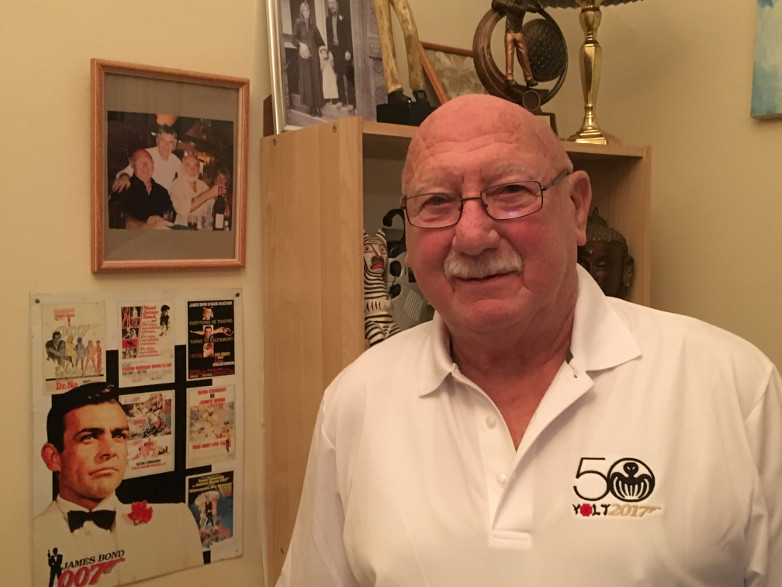
Tony Teiger i sitt hem 2017. Privat bild.
Intervjun med Tony gjordes ursprungligen av Arthur Ward i augusti 2006 och uppdaterades av Anders Frejdh i december 2017 fûÑr exklusiv ompublicering pûË FSWL med vûÊnligt tillstûËnd frûËn The Cinema and Television Benevolent Fund (CTBF).
Taggar:
#intervjuer
#man_lever_bara_tva_ganger
#max_von_sydow
Tweet
